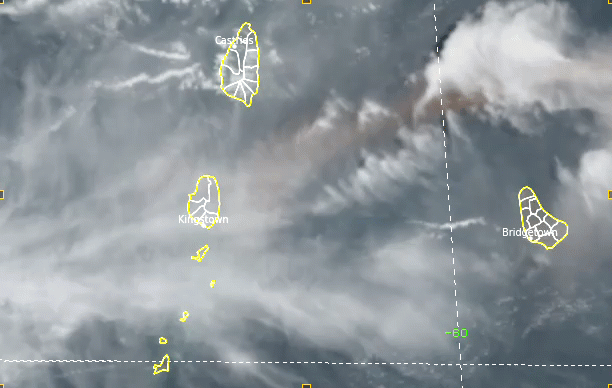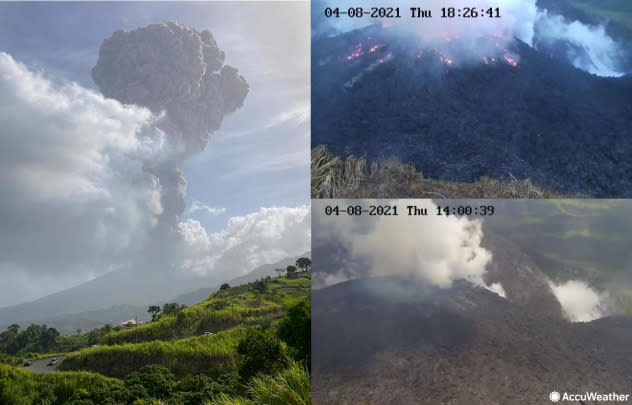Caribbean volcano erupts, prompts thousands to evacuate
- Oops!Something went wrong.Please try again later.
- Oops!Something went wrong.Please try again later.
The largest volcano on the Caribbean island of St. Vincent erupted on Friday in spectacular fashion, sending an ash plume shooting an estimated 52,000 feet into the atmosphere and forcing the evacuation of thousands.
Through the weekend, much of the island was covered in ash from the eruptions that continued on through Friday night. By Sunday night, eruptions were firing up again as conditions worsened.
Dozens of residents required rescuing from the northern part of the island as the new dangers place even more islanders at risk.
 |
A man rides his bicycle along the main Black Rock road, covered with ash coming from the eruption of La Soufriere volcano in the neighboring island of St. Vincent, on the outskirts of Bridgetown, Barbados, Sunday, April 11, 2021. (AP Photo/Chris Brandis) |
Richard Robertson, a geologist with the University of the West Indies Seismic Research Centre, said during a Sunday night news conference that there is evidence of pyroclastic flows, the rush of super-heated gas and debris traveling down the mountainside as fast as 120 miles per hour, in the areas around the volcano, NPR reported.
"These flows are really moving masses of destruction," Robertson said. "They just destroy everything in its path. Even if you have the strongest house in the world, they will just bulldoze it off the ground."
The abrupt eruptions continued to launch debris and a cloud of ash into the air throughout Sunday night, leaving its remnants scattered throughout the island.
Views from the Observatory this morning taken by @VincieRichie. If being shared please credit: The UWI Seismic Research Centre. #lasoufriere #svg #uwi #redalert #stilldangerous pic.twitter.com/0nH4qMS2vk
— UWISeismic Research (@uwiseismic) April 11, 2021
On Saturday, he said the roughly 110,000 residents of St. Vincent, many of whom have already sought refuge on other islands, should expect to see the largest blast of their lifetimes in coming days
"The explosive eruption has started and it is possible you could have more explosions like these," he said during a press conference on Saturday, according to NPR. "The first one is not necessarily the worst one, the first bang is not necessarily the biggest bang this volcano will give."
The volcano on the island of St. Vincent in the Caribbean appears to be erupting again with several plumes in the last few hours. pic.twitter.com/2BgHXe7jF9
— NWS El Paso (@NWSElPaso) April 11, 2021
Very early Sunday morning, the National Emergency Management Organization of St. Vincent and the Grenadines (NEMO SVG) said on Twitter that a "massive power outage" was underway following another "explosive event" of the volcano. The island-wide power outage began just after 1 a.m., local time, on Sunday morning as loud rumblings continued to emit from the volcano, according News 784 in St. Vincent.
The Prime Minister of St. Vincent and the Grenadines, Ralph Gonsalves said water supplies to most of the island had been cut off and its airspace had been closed due to the smoke and plumes of volcanic ash moving through the atmosphere, according to the BBC.
St. Vincent is a volcanic island located in the Lesser Antilles of the Caribbean and is home to La Soufrière, its largest volcano.
Around 8:30 a.m., local time, on Friday, the volcano underwent what the scientists at the University of the West Indies (UWI) Seismic Research Center called an "explosive eruption," spewing ash high into the air.
The NEMO SVG reported later in the morning that the ash plume had reached about 5 miles (8 km) into the air, and ash had fallen at Argyle International Airport. A NOAA-SSEC satellite estimated that the ash traveled an astonishing 52,000 feet into the atmosphere, or about 10 miles up.
 |
Photo from the explosive eruption that occurred at La Soufriere, SVG at 8:41 am local time. Ash has begun to fall on the flanks of the volcano and surrounding communities including Chateaubelair and Petite Bordel. (Photo/UWI Seismic Reasearch Centre) |
The explosion of ash was so large that it was visible on from space on weather satellites. Southwesterly winds carried the cloud of ash over northern parts of St. Vincent and over the waters of the western Atlantic Ocean between the islands of Saint Lucia and Barbados.
NEMO reported that the ash was extending at least 20,000 feet (more than 6 km) to the northeast of the volcano.
 |
This GOES-16 true-color satellite loop shows what the La Soufriere volcano eruption looked like from space on the morning of April 9, 2021 (GOES-16/NOAA) |
Geologist Richard Robertson told News 784 in St. Vincent on Friday that the volcano had returned to a quieter period, but more eruptions are expected to follow.
A second eruption occurred later Friday evening, NEMO reported, jettisoning ash over 2 miles into the atmosphere.
Ash venting resumed at La Soufrière at around 2:45 p.m. local time, the UWI Seismic Research Center reported Friday evening, and lightning could be seen in the ash column. Continuous tremors have been recorded since 3 p.m., and the center noted that the volcano continues its explosive phase which may last several days to weeks.
 |
Friday afternoon, lightning was visible in the volcano's ash column due to its highly charged nature. (Photo/UWI Seismic Reasearch Centre) |
"If there is a much bigger explosion, the ash can spread further to the south," Robertson said, adding that, "This could continue for days or weeks, and monitoring will continue."
The UWI Seismic Research Center first noticed gases spewing from the dome of the volcano on Thursday morning.
As seismic activity continued and became more intense, with magma visible near the surface later on Thursday, the country's National Emergency Management Organization raised the island's alert level from orange to red, according to NPR, meaning that eruption was considered "imminent".
 |
Smoke spews from the glowing dome of the La Soufriere volcano in Saint Vincent and the Grenadines on Thursday April 8, 2021 (right), and the resulting eruption (left) on Friday, April 9 2021. (Photos/The UWI Seismic Research Centre) |
Around 6:00 p.m. Thursday, Gonsalves announced in a press conference the evacuation order for residents in "red zones" on the northeast and northwest sides of the island.
This evacuation includes roughly 16,000 people on the island, according to WFAA, a WABC affiliate in Dallas, Texas.
I have issued an evacuation order to all residents living in the RED ZONES on the North East and the North West of the island. All residents are asked to act accordingly with immediate effect to ensure their safety and that of their families. pic.twitter.com/AJQlCDtOPg
— Ralph Gonsalves (@ComradeRalph) April 8, 2021
Government-led evacuations immediately began, but they were to be assisted by nearby cruise line ships, arriving Friday, to help get people to safety.
However, given the ongoing COVID-19 pandemic, evacuations are more complicated than usual.
CLICK HERE FOR THE FREE ACCUWEATHER APP
Gonsalves said in his press conference that people have to be vaccinated before boarding a cruise ship or to go to another island. The minister also highly recommended those taking shelter in Saint Vincent be vaccinated.
Flights were cancelled at the Argyle International Airport on St. Vincent as well as the Grantley Adams International Airport on the nearby island of Barbados on Saturday, further complicating evacuation efforts.
Even on Friday morning, fresh magma near the surface of the volcano left the sky aglow.
The start of a new day. Long exposure photo taken by volcano seismologist Roderick Stewart at the Belmont Observatory...
Posted by UWI Seismic Research Centre on Friday, April 9, 2021
According to CNN, the La Soufrière volcano on St. Vincent has had five explosive eruptions in the past, with the most recent being 1979. There was, however, an uptick in seismic activity more recently in December of 2020.
Gonsalves urged people to be patient and continue to take precautions as experts warned that explosive eruptions from the volcano could continue for days or even weeks, NBC News reported.
In an interview with NBC Radio, Gonsalves said that it could take up to four months for life to return to normal, depending on the extent of the damage. He added that agriculture will be badly affected.
In extremely powerful volcanic eruptions, the ash and aerosols released in the eruption can pass through the troposphere, the lowest layer of Earth's atmosphere, and penetrate into the stratosphere, the second layer of the atmosphere.
If enough of the ash and other pollutants released in the eruption make it into the stratosphere, they can influence the climate around the globe. The boundary between the troposphere and stratosphere is about 6 miles (10 km) above the ground, a little higher than where commercial jets typically fly.
Keep checking back on AccuWeather.com and stay tuned to the AccuWeather Network on DirecTV, Frontier, Spectrum, FuboTV, Philo, and Verizon Fios.






